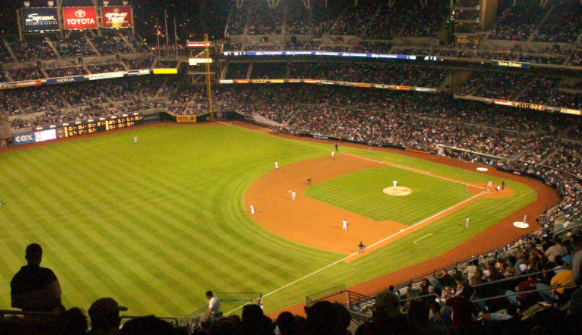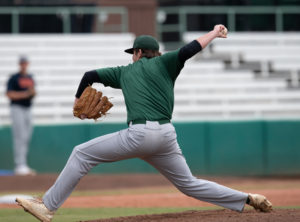With all of the commonly used baseball acronyms, it can be very difficult to keep track of all of them if you are a casual fan.
One that you may see frequently while looking at a game preview and one of the most popular baseball abbreviations is “RHP.”
So, what does RHP mean in baseball and what does LHP mean in baseball??
RHP stands for Right-Handed Pitcher, and LHP stands for Left-handed pitcher and the abbreviation RHP or LHP is used to indicate what arm the pitcher uses to throw with.
Teams strategize with different baseball lineups depending on whether a Right-Handed Pitcher or Left-handed pitcher is pitching in the day’s game.
There is a statistical advantage for the pitcher when Right Handed Pitchers face right-handed hitters, and the same goes for when there are Left-Handed Pitchers facing Left Handed hitters.
So, what are the big advantages of RHP vs Right-Handed Batters, and LHP vs. Left-Handed Pitchers?
Contents
- Advantages of RHP vs RHH and LHP vs. LHH
- Best Right Handed Pitchers of All Time
- Are Left Handed Pitchers Rare?
- What size of the plate does a right-handed batter stand on?
- What is the advantage of being a switch hitter?
- What is the three-batter rule in baseball?
- Can switch hitters change sides during an at-bat?
- What do you call a right-handed pitcher?
- Conclusion
Advantages of RHP vs RHH and LHP vs. LHH
Here are the top benefits of pitching against a batter from the same side:
1.Deception
With a right-hand pitcher vs a right-hand hitter or a left-handed pitcher vs. a left-handed batter, the angle of the release point makes it appear the ball is almost coming right out you compared to when you are facing a pitcher that throws from the opposite arm. As a result, the ball is a little bit more difficult to pick up. Scouts look for right hand pitchers that have sharp breaking balls or wipeout sliders that make it difficult for right hand hitters to hit.
One of the most deceptive LHP pitchers vs. Left-hand hitters is Madison Bumgarner, who has an arm angle that is difficult to pick up and appears to be coming directly at a left-hand hitters hip at release point. Here is a good video of some of Bumgarner’s strikeouts:
One of the best Right-Hand Pitchers vs. Right-Hand hitters was Kevin Brown, who threw from a variety of arm angles and had plenty of movement. Brown was great at inducing plenty of ground ball outs and double play outs with his sinking fastball.
2.Breaking ball moving away from the hitter
The other big advantage of RHP vs. Right-hand hitters is that their breaking balls are breaking away from the hitters.
With a breaking ball breaking away from right handed pitcher to the hitter it becomes much more difficult to hit compared to a ball that is breaking into a hitter. If a breaking ball is left hanging (mis-thrown slightly) the ball could be breaking right into the sweet spot of a hitter on the opposite side of the plate.
At the Major League Level, pitchers are so skilled they can throw “backdoor curveballs” which start out of the strike zone and break into the strike zone to catch the outside part of the plate for a strike or induce a ground ball out.
One of the best at the backdoor curveball was Barry Zito, who had a slow looping curveball that was known to freeze hitters over the years.
Best Right Handed Pitchers of All Time
| Cy Young | 1890-1911 | 511 | 2,803 | 2.63 |
| Walter Johnson | 1907-1927 | 417 | 3,509 | 2.17 |
| Christy Mathewson | 1900-1916 | 373 | 2,502 | 2.13 |
| Grover Cleveland Alexander | 1911-1930 | 373 | 2,198 | 2.56 |
| Bob Gibson | 1959-1975 | 251 | 3,117 | 2.91 |
| Nolan Ryan | 1966-1993 | 324 | 5,714 | 3.19 |
| Tom Seaver | 1967-1986 | 311 | 3,640 | 2.86 |
| Greg Maddux | 1986-2008 | 355 | 3,371 | 3.16 |
| Roger Clemens | 1984-2007 | 354 | 4,672 | 3.12 |
Are Left Handed Pitchers Rare?
Left-handed pitchers throw around 30% of all innings in Major League baseball despite only 1 in 10 people throwing lefthanded.
In baseball, there is a high demand for left-handed pitchers because of the rarity and unique skillset that can be utilized against left-handed hitters.
In fact, it is known in the scouting world that a lefty pitchers can have more flaws than a right-handed pitcher and throw several miles per hour slower, and get more opportunities for scholarships in college or consideration from scouts. So, if you are a lefty pitcher, it is important to realize you have a special gift that many would die for!
What size of the plate does a right-handed batter stand on?
From a fan’s perspective behind home plate a right-handed hitter stands on the left side of home plate and a left-handed hitter stands on the right side of the plate.
From a pitcher’s perspective,a right-handed hitter is on the right side of the plate and a left-handed pitcher is on the left side of the plate.
This can be confusing if you attend a game and see right-handed hitters on the left side from the plate but you need to remember that the best way to remember what side the hitter is hitting from is to think of the view from the pitchers.
What is the advantage of being a switch hitter?
The main advantage of being a switch hitter is that you take away the advantage the pitcher has of facing you from the same dominant side as you with the flexibility to always bat from the opposite side.
For instance, a switch hitter will bat right-handed against a left-handed pitcher and will switch to the left side if the other team brings in a right-handed pitcher.
Only around 10% of MLB hitters can switch hit, which means that it is takes a very unique skill set to be able to be equally skilled to hit from both sides of the plate.
Here is a list of some of the best switch hitters of all time with their career on-base percentage through all of their games played:
| Player | On Base percentage |
| Tim Raines | .385 |
| Roberto Alomar | .371 |
| Mickey Mantle | .421 |
| Chipper Jones | .401 |
| Eddie Murray | .359 |
What is the three-batter rule in baseball?
MLB wanted to speed up the games heading into the 2020 season and instituted a 3 batting minimum rule for pitchers before a pitching change, which reduced the amount of Left on Left or Right on RIght 1 batter changes that have long been a part of the game.
Left-Hand Specialists have been used to take up roster spots for the specific purpose of coming in and facing a Left-Handed hitter late in the game.
With the three batter rule, Major League teams have had to take a hard look at the left-handed specialist role and elected to go with pitchers that have a more diverse skill set to get both right-handed hitters and left-handed hitters out.
Can switch hitters change sides during an at-bat?
Yes, switch hitters can change during an at-bat, but they can’t change during a pitch.
So if a team brings in a new pitcher in the middle of an at-bat, the switch hitter can elect to change sides to take advantage of being a switch hitter.
One Pitcher who recently made this rule confusing was ambidextrous pitcher Pat Venditte who has the ability to throw with both his right and left arm with enough talent to pitch in the Major Leagues!
He was the first to bring this unique skillset to the major league level and as a result, Major League Baseball came up with a new rule called the “Pat Venditte Rule”
The rule goes as follows: “The Ambidextrous pitcher must declare which arm he is going to use before the batter steps into the box and to throw from that side the entire length of the at-bat.
What do you call a right-handed pitcher?
A right-handed pitcher is known as a “Righty”. Righties are the most common pitchers you will see on a baseball team since the majority of people are right-handed.
Right Handed pitchers will typically throw harder than left-handed pitchers on the pitching staff since the talent pool is so wide to choose from right-handed pitchers.
Conclusion
While we know trying to figure out what an Rhp means in baseball or what an LHP means in baseball can be a little confusing, we hope this post helped clear some things up for you and helped make it much easier to understand. Next time you watch a major league baseball game, be sure to pay attention to the pitching changes throughout the game. You will start to notice the pitching changes directly relate to whether a pitcher will face lefty or righty batters.
Other Popular Articles:


